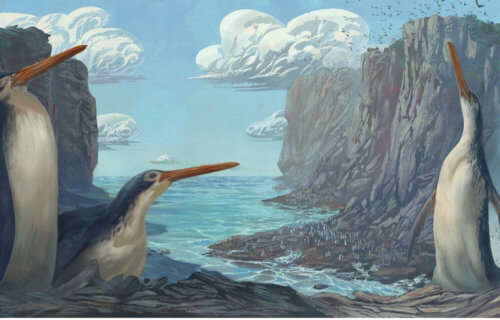
PALMERSTON NORTH, New Zealand — A penguin as big as humans once waddled around a lost world of giant creatures some 30 million years ago, new research shows. Amazingly, the fossilized bones of this giant penguins were stumbled upon by children during a school trip in New Zealand. The bones belonged to one of the tallest flightless birds that ever lived, after originally being mistaken for rusty iron poles.
The creature has been named Kairuku waewaeroa — Maori for “long legs.” It stood almost five feet and weighed about 154 pounds. The ancient continent where it lived, called Zealandia, borders New Zealand’s coast and is believed to have submerged into the sea approximately 79 million years ago.
Kairuku waewaeroa would have towered over today’s Emperor penguin, which can reach four feet. It adds to the growing list of Zealandia’s extinct megafauna, enormous prehistoric animals that inhabited it. They included monster kangaroos, wombats, lions, snakes, lizards, parrots, eagles, and bats.
“The penguin is similar to the Kairuku giant penguins first described from Otago, a southeastern region on New Zealand’s south island. However, it has much longer legs, which were used to name it waewaeroa — Maori for ‘long legs.’ These longer legs would have made the penguin much taller than other Kairuku while it was walking on land. It may have influenced how fast it could swim — or how deep it could dive,” says study co-author Dr. Daniel Thomas, a zoologist at Massey University, in a statement.
The previously discovered species, known as Kairuku waitaki and Kairuku grebneffi, were a few inches shorter than Kairuku waewaeroa. At the time, New Zealand itself was mostly underwater, with only a smattering of islets above the surface. Shallow waves rich with food and protection from predators enabled penguins to evolve in much greater proportions than their modern counterparts. They crowded onto remote, rocky outcrops, with active volcanoes turning the sky cloudy with ash.
How a group of children found the giant penguin fossils
Kairuku waewaeroa’s remarkably complete skeleton was dug up by children from Hamilton Junior Naturalist Club on a field expedition. Now an international team has 3D-scanned the fossil for the first time and compared it to digital versions of bones from around the world.
“It’s been a real privilege to contribute to the story of this incredible penguin. We know how important this fossil is to so many people,” says Dr. Thomas. “Kairuku waewaeroa is emblematic for so many reasons. The fossil penguin reminds us we share Zealandia with incredible animal lineages that reach deep into time. It gives us an important guardianship role. The way the fossil penguin was discovered, by children out discovering nature, reminds us of the importance of encouraging future generations to become kaitiaki — Maori for guardians.
The fossil penguin has been donated to the Waikato Museum near where it was found at Kawhia Harbour on the North Island’s west coast. Peter Jackson chose the area to film the Lord of the Rings and Hobbit movies.
The Hamilton Junior naturalists were awarded a 3D-printed replica of the fossil described. Mike Safey, President of the Hamilton Junior Naturalist Club, says the children will remember the 2006 expedition for the rest of their lives. “It was a rare privilege for the kids in our club to have the opportunity to discover and rescue this enormous fossil penguin. We always encourage young people to explore and enjoy the great outdoors. There’s plenty of cool stuff out there just waiting to be discovered,” says Safey.
His son Steffan Safey was there for both the discovery and rescue missions. “It’s sort of surreal to know a discovery we made as kids so many years ago is contributing to academia today. And it’s a new species even,” he says. “The existence of giant penguins in New Zealand is scarcely known, so it’s really great to know the community is continuing to study and learn more about them. Clearly, the day spent cutting it out of the sandstone was well spent.”
Taly Matthews, a long-time member of the club, now works for New Zealand’s Department of Conservation. “Finding any fossil is pretty exciting when you think about how much time has passed while this animal remained hidden away, encased in rock. Finding a giant penguin fossil though is on another level. As more giant penguin fossils are discovered we get to fill in more gaps in the story. It’s very exciting,” she said.
Penguins have a fossil record reaching almost as far back as the age of the dinosaurs. Giant penguins are believed to have been killed off by the emergence of seals and smaller whales. Kairuku waewaeroa is the most complete fossil of its kind and will shed fresh light on their evolution.
The fossil finding is described in the Journal of Vertebrate Paleontology.
South West News Service writer Mark Waghorn contributed to this report.
